You are about to hear the possible original Anunnaki language, translated from Babylonian clay tablets by the team of Dr. Martin Worthington, of Cambridge University, is AVAILABLE on 'net. They have put several samples of scriptures, poems and epics as the "Atrahasis", "Enuma Elish" and "The Hammurabi Code", with loads of mentions about the ancient alien-gods and reports of events that happened during their colonization on Earth. Coincidence or not, these audio files were announced at the same week that astronomers had announced an Earth-like planet with 100% odds of life, on Gliese 581 system. All suggest some scheduled movement of TPTB, on the preparing to return of the Anunnaki.
| Sumerian History: Ancient Sumeria covered a wide area of what we know of as Ancient Mesopotamia[26]. Based on everything that I have come across, Ur could have been the main governing city of the other cities or kingdoms of Ancient Mesopotamia (such as Erech, Kish, what would become Babylon, etc). |
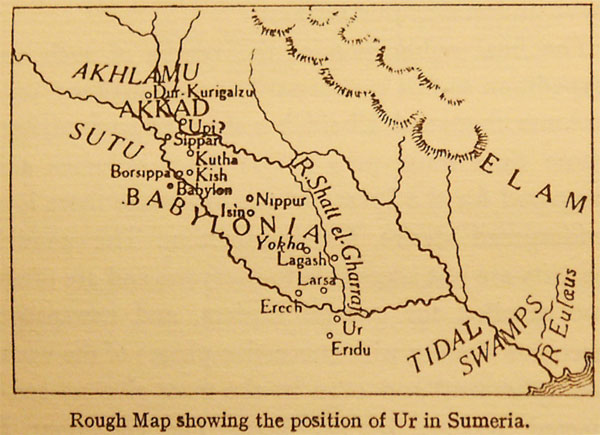
Ur (of the Chaldees) was also known as "The Mound of Pitch" and was the home of Abraham[28]. Towards the end of the 19th century the University of Pennsylvania sent out an expedition to Ur and conducted excavations but didn't publish what they had found[29].
The Sumerians had written about a great Flood (also known as Deluge), centuries before Abraham. Two or three Sumerian cities were said to have existed equally before the Flood and after it.[30]
Deeper digs at Ur revealed that there was a thick layer of clay (deposited by water) which above it were purely Sumerian remains of pottery and so forth, but below the thick layer of clay was evidence of a mixed culture being Sumerian and another race (referred to as al'Ubaid type) which had apparently inhabitied the river-valley before the Sumerians had arrived[31].
Limestone roofing has been found at Ur as well, a stone that is not available at Ur indicating that it was brought in from an area about 30 miles away if not further[32].
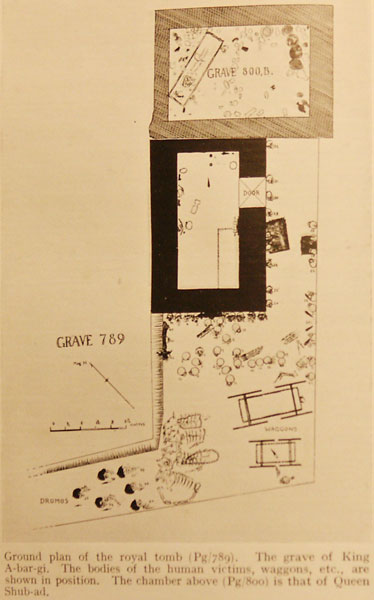
One of the things that the Sumerians did when they built a structure was to add a foundation stone with inscriptions on it[34]. Foundation cones were also employed either placed in the foundation or inside of walls.
While it is believed that the Sumerians settled what we know of as Ancient Mesopotamia after coming from the hilly country of the East, the study of their skeletal remains shows that they were not Oriental (as one would surmise) but rather caucasian Indo-European[35].
The infamous Tower of Babel was nothing more than a design repetition on a larger scale of the Ziggurat (tower or temple) at Ur[36].
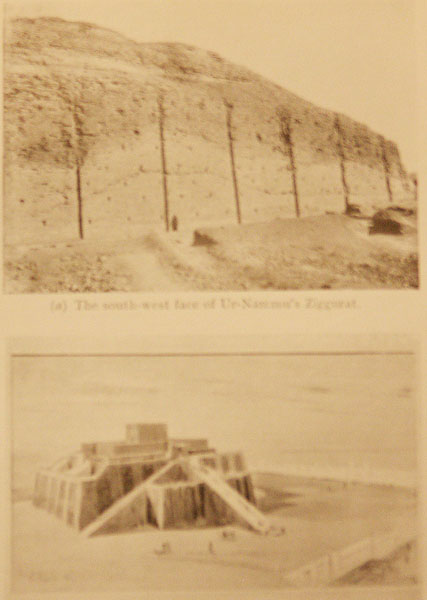
A building from the time of Bur-Sin had been the gateway of a Ziggurat known as "The Great Gate", his court of justice. The immemorial custom of the East, the judge sits in the gate to give judgement; presumably after the judgement is reached it would be announced to any crowd assembled in the courtyard[38].
King Nebuchadnezzar (around 600 B.C.) restored many of the old Sumerian cities, particularly at Ur where virtually all of the center of the city and the complex of religious buildings which made up the "Sacred Area" has been found to be overlaid with his restoration efforts[39]. As a side note, King Nebuchadnezzar is known to have had a son with the name of Nabonidus[40].
According to the king-lists, the history of Sumeria goes back to the creation of man with 10 generations from Adam (or Adapa) to Noah, a Chaldean Monarch. The 10 generations (ancestral kings or ur-kings...Methuselah among them) covered a span of 456,000 years (the Sumerian record only covers eight of the ancestral kings covering 241,200 years)[42].
Superstition of the black cat goes back as far as Ancient Sumeria[43].
The medical art of Babylonia has its roots from Sumer (Babylonia had state-supported medical schools)[43].
The infamous arch that is seen in Babylonian, Greek, Roman and other structures had originated as far back as 2500 B.C. in the royal tombs of Ur (they were also used in Sumerian housing, the temple of Kuri-Galzu and other places[44].
Sumerians are believed to have been in India (ancient seals found beneath the foundations of old Buddhist buildings of the 3rd century B.C. - 2nd century A.D.), British Isles (ancestors of the Britains) specifically around Cornwall and further west to the land of Erin[13] (Erin known as Urani; known today as Ireland[14] for which engravings on prehistoric cup-marked stones at New Grange (near Drogheda) are those of Early Sumerian and Hittite sacred seals[15]), North-western Europe and the Mediterranean[1] aside from the commonly known area of ancient Mesopotamia and Egypt[7].
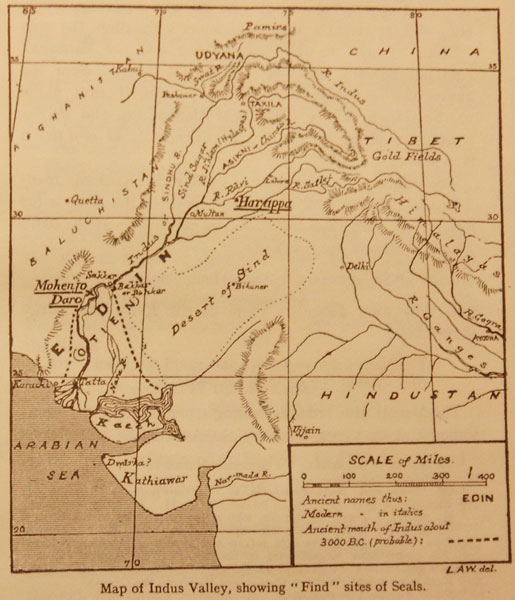
The Sumerian King Uruas' (Ur Nina) was the son of Hercules of the Phoenicians and Greeks identified with the Sumerian epic hero "Gilgamesh" of Erech (Erek) (Gilgamesh or "Gis'zax" being a king and Sun-priest of Bel (Induru or Indara by the Hittites) around 3150 B.C.)[1]. The Hittites were in Syria in text noted by superscript[45].
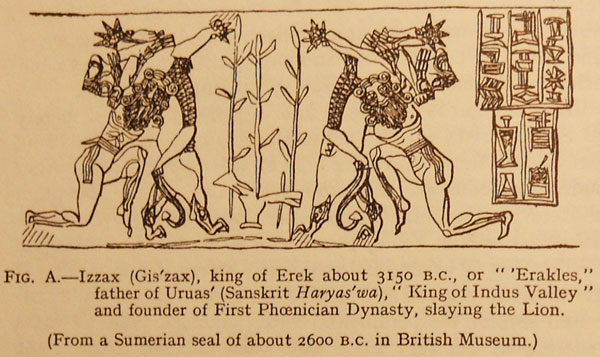
Pictures of Izzax of Erek:
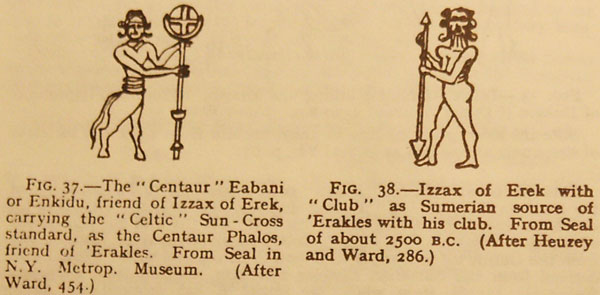
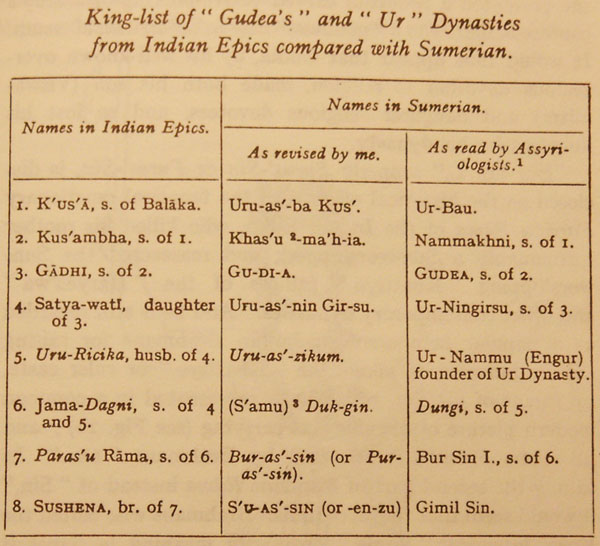
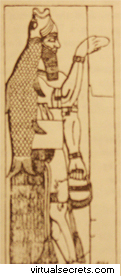 Image of Ea, Hea, Oannes | Most texts associate the image (to the left) to the god Ea (Hea)(Oannes) who was the one which imparted arts and civilized life. However, one text has suggested that this image was the Sun Fish-man (S'ukka or Biesh) who bestowed the ambrosia of Resurrection and Life, which is contained in the basket[4]. A relatively new interpretation of the pointed object he is holding up is akin to a pine cone or possibly a ritual involving the pineal gland; the container (what appears to be a bucket) held genetic material or DNA. |
The pre-dynastic Pharaohs of Egypt were Sumerians from about 2780 B.C.[5]. At the time of Sargon (Sargon the Great) Egypt was referred to as Mizir or Dilmun and his tomb (as a predynastic Pharaoh) was found at the royal tombs at Abydos (in Egypt today)[8].
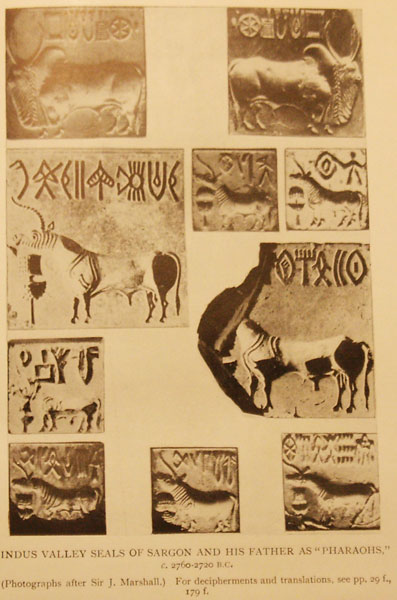
Menes (Manj of Egyptian legend) (Manis of Mesopotamia) (Min or Minos of Greek legend) erected Egypt into an independant kingdom and preserved its independence within the Mesopotamian empire when he succeeded to the throne after his father's death; Menes was the prince of Sumeria and governor of the Sumerian Indus Valley. Menes annexed and civilized Crete and extended his rule to the Pillars of Hercules and Britain[5].
Menes was the son of Sargon (who had a Queen named Lady Ash[9]), or "Sargon the Great"[6] of ancient Mesopotamia and Menes and his dynasty referred to themselves as "Gut"(Goth) (in Indus Valley seals) and "Bar" or "Par"(Pharaoh) (as referred to in Egyptian records).
Menes' Egyptian inscriptions were written in Sumerian script (not the later conventionalized hieroglyphs) and deciphered to match Menes' Mesopotamian and Elam records as well as his official seals in the Indus Valley (where he was a Sumerian governor there until he revolted against his father (Sargon) and annexed Egypt)[10]. Menes had a son named Narmar or Naram (Naram Enzu) whom he sent to the Indus colony of Edin as a viceroy.
The massive Sumerian empire split into two sections what we could consider today as Europe and the Near East (or Middle East) about 2522 B.C. thus forming the "West" and the "East"[16].
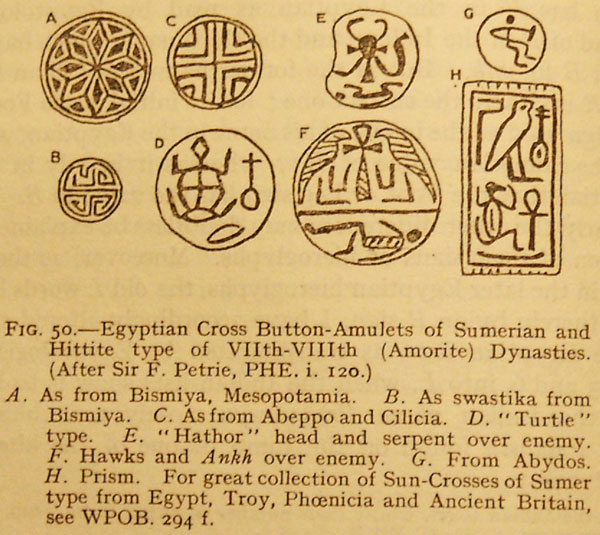
"...when An (and) Enlil had called Lipit-Ishtar--Lipit-Ishtar, the wise shepherd, whose name had been pronounced by Nunamnir--to the princeship of the land in order to establish justice in the land, to banish complaints, to turn back enmity (and) rebellion by the force of arms, (and) to bring well-being to the Sumerians and Akkadians, then I, Lipit-Ishtar...procured...the freedom of...the sons and daughters of Sumer and Akkad upon whom...slaveship...had been imposed."[18]
Sumer (periodically attacked by wandering tribes to the West and mountain peoples of the North and East), in the delta region of southern Mesopotamia where the Euphrates and Tigris rivers flow into the Persian Gulf, is believed to have been settled as early as 6000 B.C. by the Sumerians[19]. As early as 3000 B.C. the Sumerians were already skilled in writing and were drafting deeds and bills of sale for the transfer of title for houses, lots and slaves[20]. Before 2200 B.C. Sumerian priests had warned people that they could not kill, rob, rape, commit adultery, swear falsely, or deprive one another of their freedom with impunity[21]. In fact the Sumerian judges scrupulously guarded property rights of individuals and even went so far as to provide compensation for victims of robberies (even to slaves of that era); California in 1965 became the first state to create legislation of similair nature; of equal interest may be that the individuals who drafted Hammurabi's Code believed that property acquired by one or both spouses during marriage should be equally shared between both[22].
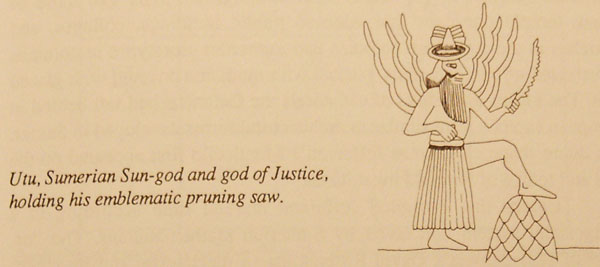
Noah, a Chaldean Monarch[23] at or near Surippak (port near the entrance of the Euphrates river into the Persian Gulf), was known under several names. Some of them were: (Adrahasis, Hasisadra, Xisithrus)[23].













No comments